
It's Time to Write in the Journal
Page 3
.
click here to return to other journal pages
This year, 2007, marks Tapissary’s 30th anniversary. To celebrate, I’ve been making some adjustments to the grammar. For practice, I decided to write this journal in which I will periodically add entries. The spoken version of my language comes in 2 flavors. "Tapisi" sounds like a French Slavic blend, while "Sevens" takes English vocabulary as its base. The celloglyphs (hieroglyphs) are written the same for both the Tapisi and Sevens styles. I should add that the celloglyphs themselves do not have a computer font, so the only postings of my writing using the celloglyphs are done by occasional photos and jpegs. The entries below are written in Sevens, which transcribes Tapissary into the Latin alphabet.
The formulae you see preceding each phrase below (such as: [≈] + ∆ ) refer to the cyclic grammar. They are temporary training wheels to help me clarify the dynamics within each sentence. The symbols themselves do not show up in written Tapissary, but rather influence specific grammatical functions. I have written them in subtle color to keep their distraction level low.
.
.
journal entries
July 18 2007
Even though I have a sore throat this morning, I decided to make a recording of yesterday’s entry. (Some visitors have been experiencing problems with my previous sound files on this site, so I am changing over to the mp3 format in hopes that it will be more accessible). The text is read in Sevens, which is Tapissay slotted into spoken English... with just a soupçon of French. You will be able to understand most of it even before reading the translation. The rising and falling intonations are an indication that the cyclic grammar is in play. Here, once again, is yesterday’s text read in Sevens:
Ith’ii wastant avoir a model ship I ever since I can remember. For now, thaàt must suffice in paper form. Here is a ship ips* ii drew in l’imaginary sea that lahap Ventiçellon shoñre. IIt is part yse large computer image I’m preparing for my exhibit called “Thee Fortress in a Secret Alphabet”. Se blackened background on which se ship saihail and se harbor receiheive, is a detail ythe celloglyph meaning ‘fortress’. Still on se wkipieecing. Plenty of chañnge gejet thebeere before it’s complete.

*Error: I said 'that' instead of 'ips' on the recording. They do not mean the same thing. My lesson for the day: "Haste mewaaste" (Haste makes Waste).
.
July 17 2007
.
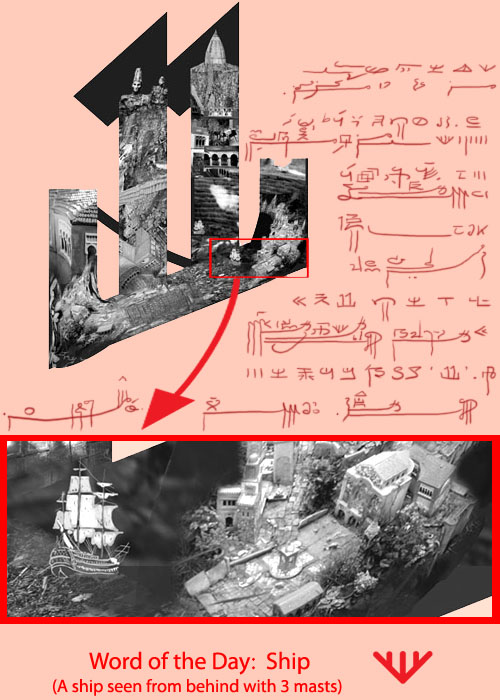
.
[=] ∆ + /\ I have wanted to have a model ship ever since I can remember. For now, -- | that will have to suffice in paper form. [=] | + | Here is a ship I drew in the imaginary sea that laps Ventiçello’s shores. + | It is part of the large computer image I’m preparing for my exhibit called “The Fortress in a Secret Alphabet”. + | The blackened background on which the ship sails and the harbor receives, is a detail of the celloglyph meaning ‘fortress’. + /\ I’m still working on the piece. [≠] +<> There will be plenty of changes before it’s complete.
Ith’ii wastant avoir a model ship I ever since I can remember. For now, thaàt must suffice in paper form. Here is a ship ips ii drew in l’imaginary sea that lahap Ventiçellon shoñre. IIt is part yse large computer image I’m preparing for my exhibit called “Thee Fortress in a Secret Alphabet”. Se blackened background on which se ship saihail and se harbor receiheive, is a detail ythe celloglyph meaning ‘fortress’. Still on se wkipieecing. Plenty of chañnge gejet thebeere before it’s complete.
.
July 16 2007
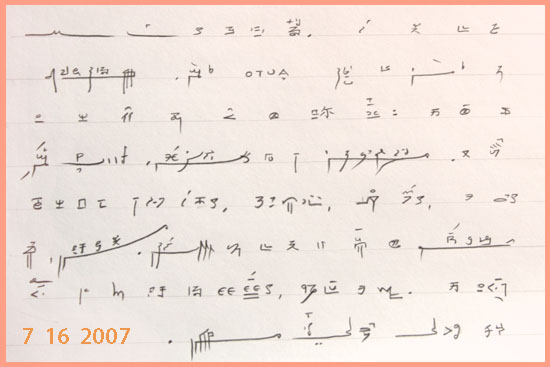
[=] /\ + /\ I’m learning to use my digital camera. -- | For the longest time, I’ve only been using AUTO mode. + /\ But photographing written Tapissary on a white or cream page presented problems: the pages always looked dark. +<> I decided it was time to read the instruction manual. + /\ I discovered the P mode. + ∆ There’s a lot to consider for lighting. + /\ With this in mind, I’m summoning patience, [≠] + /\ and hoping that good results pay me occasional visits during the long process of learning. [=] + /\ In the meanwhile, I get odd looks from people while photographing street curbs, dead leaves and tar. +<> The onlookers’ curiosity reciprocally peeks my interest in them.
Idre sccihiiing my digital istocaamera. For tra longest time, n’iì only undrusing AUTO nomoòde. But photographing written Tapissary on a white or cream page present meprondooñblem: se pañge always loondook dark. I deceindeid it was time laread se instruction mamwaanual. Discover the P hnimondood. There’s a lot it laconsider for lighting. With this in mind, summon mipaatiencing, and hoping that pay good miresuuñlt occasional viñsit during thee long process ylearning. In tra meanwhile, odd gtilooñk from people while photograph street micuuñrbing, dead leaves and tar. Se oñnlookerin curiosity reciprocally peeheek my imiinterest in them.
.
July 15 2007
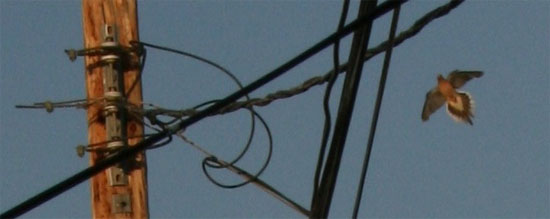
[=] /\ + __ The crows came and left too quickly to set up the camera. + | One dove, however, trailed behind, +<> giving me the extra second I needed to point the lens. [≠] + /\ I hoped the timing would provide me with a readable image of the bird in flight. [=] + /\ I am grateful that the shutter went off before the dove passed behind the wires, with his wings and tail feathers in full extension. [=] /\ + ∆ He’s coming in for a landing atop the pole.
S’idre nocrooñw came and left too quickly to set up ge nocaamera. One doove, however, traihail behind, giving me tr’extra second I neeheed to point ge lens. I hondope would provide tra mitiiming with a readable image yse bird in flight. I am grateful that ge shutter went off before se dove pass behind se mewindiiñre, with his wiñng and tail featheñr in full extension. Idre he’s coming in for a landing he atop ge pole.
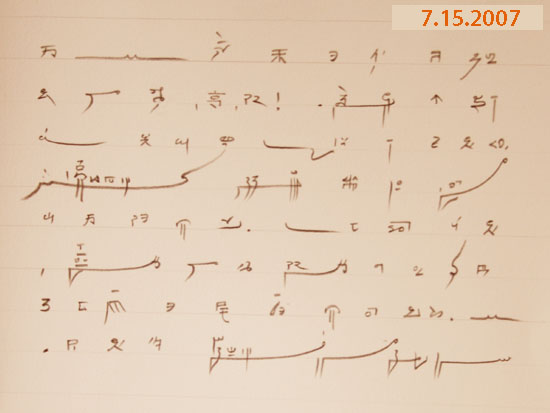
.
July 14 2007
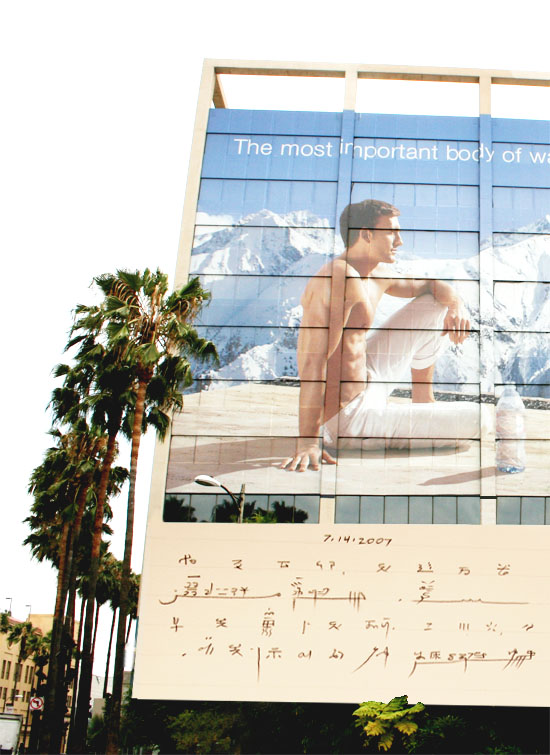
[≠] ∆ ≠ /\ Even without his shirt, the young man will not freeze. + /\ The tropical breezes from palm tree lined avenues relax the drafts from the Alps. [=] | + ∆ This is fortunate, because when you measure 7 or 8 stories high, + <> you are far more exposed to the weather.
Even without his shirt, ge frost se young ithe gtemajaans. Tra tropical breeñze from palm tree lined avenueñ relax tra rtewdraañft from ge Alps. This is fortunate, because when you measure 7 or 8 stories high you, you are far more exposed to tra weabyeaather.
.
July 13 2007
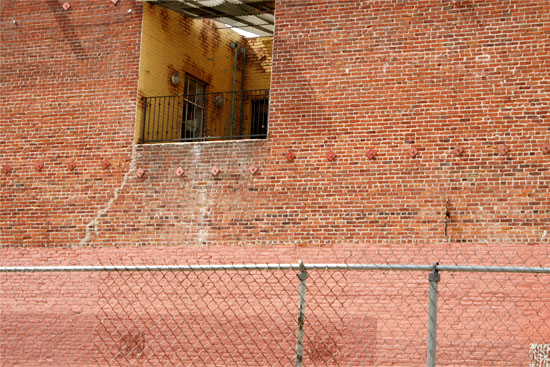
[=] ∆ + | The wall faces us like a saturated page. + | Rows and rows of bricks display their patient text. [=] /\ + /\ A cubicle space funnels the flatness. + <> Suddenly the story is lined with human character.
G’ithe waall fahace us like a saturated page. Rooñw and rooñw ybriñck display their patient text. A cubicle space funnel g’idre meflaahatness. Suddenly thee piicture is lined with human articulate-fire.
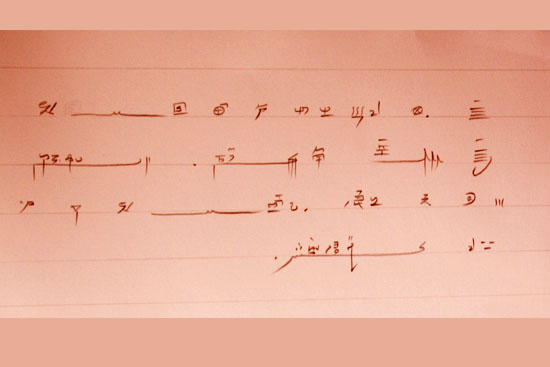
vocabulary note: In <>, story = articulate-picture. / character = trained-fire.
.
July 12 2007

+ ∆ On Language We Tread
[=] l + l A couple days ago I took this photo of people walking across the boulevard. [=] /\ + /\ On exactly how many words do we step each day? + ∆ What percentage of those are hieroglyphic, such as arrows, bars, hearts, smiley faces, and Xs for crossings? There certainly is a lot of writing and pictures painted on our roads. + /\ Why not call a boulevard a scroll? + l “Where do you live?” “8904 Palm Scroll, apartment 214 B”.
We On Language Tread Wee
A couple day ago ips ii took this photo of people walking across ge boulevard. On exactly how many step idre ptiwwoordim each day? What percentage of those are hieroglyphic it, such as arroñw, bañr, heañrt, smiley fañce, and Xim for crossiñng? There is certainly a lot of writing and pictuñre they painted on our roañd. Why not a scroll a smniwbouulevard? “Where you live you?” “8904 Palm Scroll, apartment 214 B.”
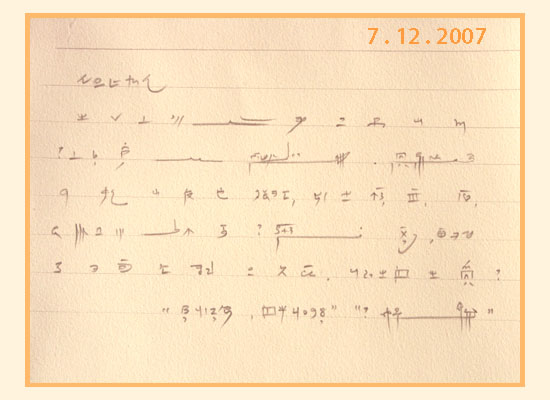
This text is the translation of the above entry in written Tapissary
.
.
July 11 2007
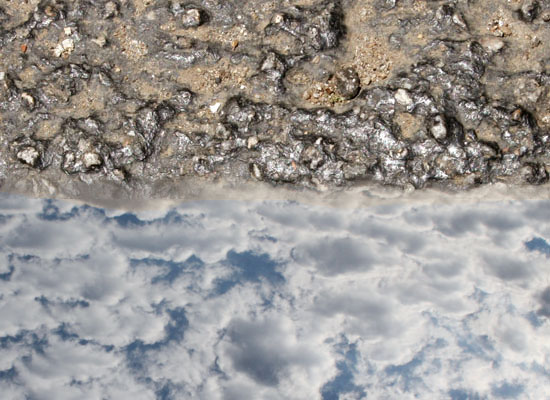
[=] l + l Here I am back at another curb. [≠] -- l The tar asphalt would have been shown bordering the concrete curb’s surface [=] + /\ had I not replaced it with its other neighbor, the sky. + ∆ These clouds billow directly over the tar; a neighborhood couple. [≠] /\ + /\ If you are noticing the similarities of design between rock and air, and their flipped orientation, + <> then you will have an introductory understanding of [=] + <> how I treat the relationship of nouns and verbs in Tapissary. + /\ If you are a firm believer that a road’s place is on the ground, and a sky’s place is up above, then you might want to consider where UP and DOWN are respectively in language. + ∆ If a road is as high in the sentence’s hierarchy as the clouds, then + <> their grammatical equality might unveil the psychological face of a mutual exchange.
Here ips ii am back at another curb. Ge concrete curbin suùrface would shostowed bordering ge tar asphalt, replace mihindriits with its other neighbor, tra sky. These cloud billow directly over ge tar theey; a neighborhood couple. If thee similaritym of design between rock and air and their flipped orientation notice hnéyouuing, then se fronting stalk splijit an introductory swoording of how treaheat la inner hearth blooodship of nounim and verbim. If you are a firm believer that a roadin place on g’egrouund, and a sky’s place is up above, then might want consider hnésuuch where UP and DOWN are respectively in language. If a road is as high in the sentence’s hierarchy iit as tra clouds, then their grammatical loaded dice might unveil thee psychological sense maap of a mutual exchange.
Note: In the same way that Chinese and Japanese vocabulary words usually come in a pair of characters, such as SUN + ROOT meaning "Japan", Tapissary usually pairs 2 concepts to make a single noun when in the <> mode of its grammar. Example from above: A "fronting stalk" means 'you'. A "split swording" means 'understanding'. So, "you will have an understanding" is rendered as: "the fronting stalk will have a split swording". Keeping the pairs apart from one another is considered a stiff style. The more Tapisreal way of using the <> sentences, is to blend them, while retaining their intelligible essence. So, the verb 'to have' may be replaced with part of one of the pairs, in this case, from 'split swording'. Now this gives, " the fronting stalk SPLITS the swording." You could also say, "the stalk FRONTS the split swording".
Addendum: (on 7 17 07) Most of the explanation mentioned above holds, however, I made the mistake of having applied the paired vocabulary to <>, when in fact the pairs should have been assigned to V. My apologies.
.
.
< page two........page four >